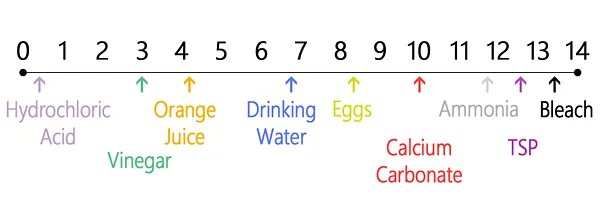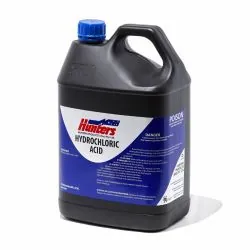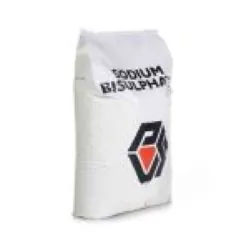The pH level, or potential of hydrogen, indicates the acidity or alkalinity of pool water, determined by the concentration of hydrogen ions. It is measured on a scale ranging from 1 to 14. As outlined in the Halogen/Chlorine module, maintaining the correct pH is vital for achieving the overall objectives of water chemistry in pools.
PROVIDE WATER THAT IS:
BACTERIA FREE.
ALGAE FREE.
NOT IRRITANT TO SWIMMER EYES, NOSE
AND SKIN.
AESTHETICALLY PLEASING, FREE FROM TASTE AND ODOUR.
THAT IS IN A PASSIVE STATE TO ITS SURROUNDS.
Let's discuss pH in more detail, this may be technical in nature, but this is essential to express how pH is calculated and how it is affected by chemical, and environmental intervention.
What is pH?
pH is a quantitative measure of the acidity or basicity of aqueous or other liquid solutions. It translates the concentration of hydrogen ions into numbers between 0 and 14. In pure water, which is neutral, the pH is 7. A solution with a pH less than 7 is considered acidic, while a pH greater than 7 indicates basic or alkaline properties1. Essentially, pH represents the balance between acidic and alkaline components in a solution.
Why is pH Important?
Chlorine effectiveness: Proper pH ensures chlorine works optimally.
Swimmer comfort: Balanced pH prevents skin and eye irritation.
Equipment protection: Maintaining the right pH prevents damage to pool surfaces and plumbing.
Effect of rain on pH levels
Heavy or prolonged rain events can affect the pH levels in swimming pools. While pH levels may appear to rise while it is raining due to aeration of the surface. In the long term rainwater is typically slightly acidic, with a pH around 5.0. When it mixes with your pool water, it can lower the pH, making the water more acidic. This can lead to discomfort for swimmers and potential damage to pool equipment and surfaces.
Additionally, rain can introduce contaminants and dilute the chemicals in your pool, further disrupting the chemical balance41. It’s important to test and adjust the pH levels after heavy rainfall to maintain a safe and comfortable swimming environment.
A need to adjust the pH levels after rain is essential?
Effect of aeration on pH levels
Aeration can have a significant impact on the pH level of swimming pool water.
Here’s how it works:
Increases pH:
Aeration introduces air into the water, which increases the rate of carbon dioxide outgassing. This process reduces the amount of carbonic acid in the water, thereby raising the pH level without affecting total alkalinity.
No Chemical Use:
It’s a natural method to adjust pH levels, making it a great option if you prefer to avoid adding chemicals to a pool.
Time Factor:
The time it takes for aeration to raise the pH can vary. Unlike chemical adjustments, which can be relatively quick, aeration might take several days to show noticeable changes.
Additional Benefits:
Besides adjusting pH, aeration can also help cool down pool water, especially in hot climates, and improve overall water circulation.
Forms of aeration:
Air blowers, waterfalls, water blades, fountains, heavy or prolonged rain events.
Key considerations:
Utilizing aeration to adjust pH levels is not a viable method. For accurate pH testing, select a representative sample away from waterfalls, fountains, operational blowers, or during intense or extended rainfall.
For pools or spas equipped with aeration devices, it is crucial to inform customers about the necessity of consistent pH monitoring and adjustment, or the implementation of automatic pH control and dosing systems.
Effects of pH Imbalance:
High pH:Causes calcium scaling on pool surfaces.
Reduces chlorine effectiveness.
Leads to cloudy water.
Low pH:Corrodes pool materials (plaster, metals, grout, tiles).
Increases chlorine effectiveness, but risks water being too corrosive.
Testing and adjusting pH:
Regularly test pH using a reliable kit.
To raise pH (if too low), add buffer (sodium bi-carbonate) or soda ash (sodium carbonate).
To lower pH (if too high), add muriatic acid or dry acid (sodium bisulfate).
pH is defined as the negative logarithm of the concentration of H+ ions. As a result, the meaning of the name is justified as hydrogen power.
We know that not all acids and bases react at the same rate with the same chemical compound. Some react violently, others moderately, and still others do not. To quantify the strength of acids and bases, we use a universal indicator that changes color depending on the concentration of hydrogen ions in the solution. In general, the value of acids and bases is used to quantify their strength.
Although less intuitive, the mathematical definition is more useful overall. It states that pH equals the negative logarithmic value of hydrogen ion (H+) concentration.
pH = -log [H+]
The pH level is determined by the activity of hydrogen atoms, which is a good indicator of the acidity or alkalinity of water. The scale ranges from 0 to 14, with 7.0 being neutral. Water with a low pH is said to be acidic, while water with a high pH is said to be basic, or alkaline.
Acids and Bases Review
There are several ways to define acids and bases, but pH specifically refers to the concentration of hydrogen ions in aqueous (water-based) solutions. Water dissociates into a hydrogen ion and a hydroxide.
Water shows amphoteric nature (it can act as both an acid and a base). Two water molecules react to produce hydronium and hydroxide ions:
This is also called the self-ionisation of water.
This equation can also be represented as;
The reaction can be shifted to the reactants or products, as expected for any equilibrium:
When an acid (H+) is added to water, the equilibrium shifts to the left, and the concentration of OH– ions decreases.
When a base (OH–) is added to water, the equilibrium shifts to the left, and the concentration of H+ decreases.
When calculating pH, keep in mind that [ ] stands for molarity, M. Molarity is measured in moles of solute per litre of solution. If the concentration is given in a unit other than moles (mass percent, molality, etc.), convert it to molarity before applying the pH formula.
The relationship between pH and molarity can be expressed as:
Kw = [H+] [OH–] = 1 x 10-14 at 25°C
for pure water, [H+] = [OH–] = 1 x 10-7
Kw is the dissociation constant of water
Acidic Solution: [H+] > 1×10-7
Basic Solution: [H+] < 1×10-7
The pH of Acids and Bases
A solution’s pH ranges from 0 to 14.
In conclusion:
Due to the role that pH plays in the efficiency of chlorine and in the effects it can have on pool surface, equipment and reliability of chemical test results.
Constant monitoring and adjustment of pH is crucial, we will provide parameters and dose rates in another module. We will discuss how Total Alkalinity acts as a pH stabiliser and is an important component in water chemistry is next.
If you are interested in learning more about this subject, go to the following online resources for a deeper dive.
pH - Definition, Calculation, and Significance (scienceinfo.com)
What Is pH? The pH Formula & Equation | ChemTalk (chemistrytalk.org)
Hyrochloric Acid Vs Sodium Bisulphate
Hydrochloric Acid (Muriatic Acid):
Pros:Highly Effective: HCl is a potent acid that effectively lowers both pH and total alkalinity in pool water.
Stain and Scale Removal: It can remove mineral deposits, stains, and scale buildup from pool surfaces.
Quick Action: HCl works rapidly to adjust water chemistry.
Cons:Safety Hazard: Handling HCl requires caution due to its corrosive nature.
It can cause burns and respiratory irritation.
Storage and Handling: Proper storage and protective gear are essential.
Cost: HCl is generally more affordable than sodium bisulfate.
Environmental Impact: Disposal of HCl must be done carefully to avoid harm to the environment.
Sodium Bisulfate (Dry Acid):
Pros:Safer to Handle: Dry acid (sodium bisulfate) is granulated and less hazardous than HCl.
Ease of Use: It dissolves easily in water, making it convenient for pH adjustment.
Algae Prevention: Helps prevent algae growth by maintaining proper pH.
Compatibility: Compatible with various pool types and other chemicals.
Cons:
Cost:Sodium bisulfate is more expensive than HCl.
Slower Action: It may take longer to adjust pH compared to HCl.
Environmental Impact: While safer, it still produces an acidic solution when mixed with moisture.
Choosing the Right Acid:
Safety First: If safety is a top priority, opt for sodium bisulfate.
Efficiency: If rapid pH adjustment is crucial, consider HCl.
Budget: Consider cost implications.
Long-Term: Evaluate long-term costs and environmental impact.





